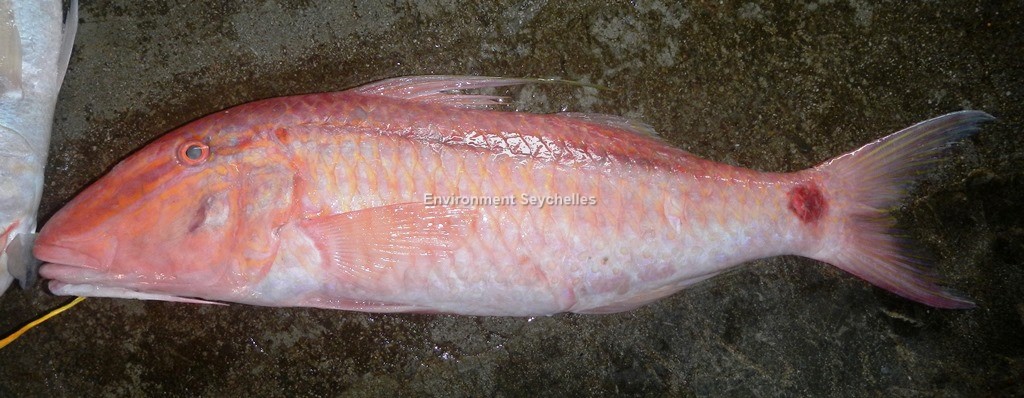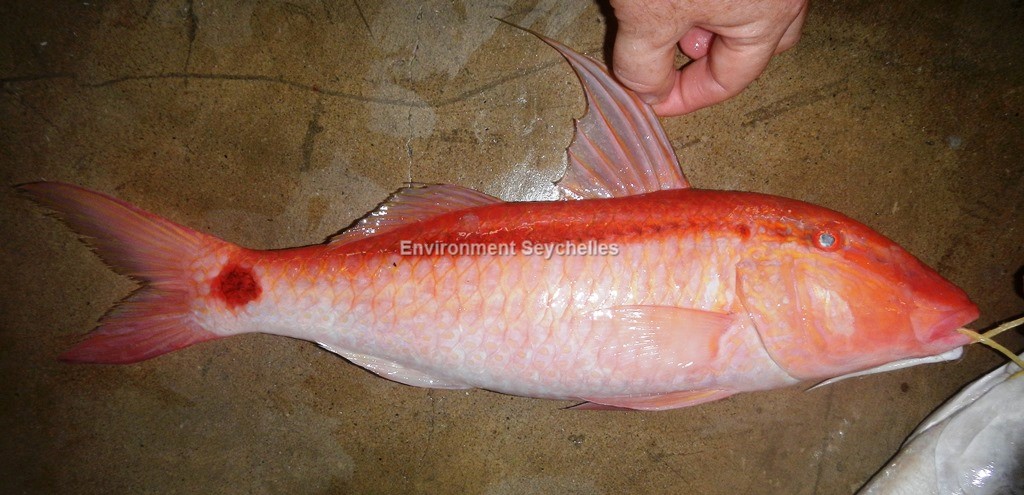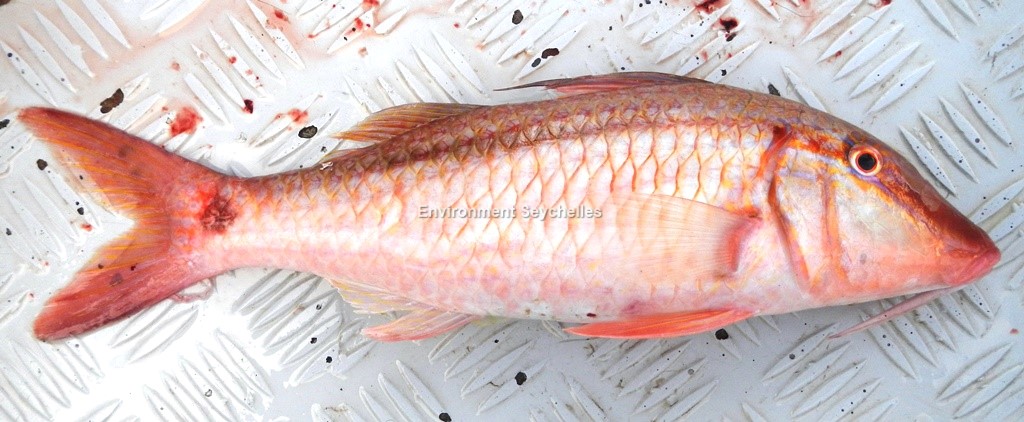Description:
Dorsal spines: 8; Dorsal rays: 9; Anal spines: 1; Anal rays: 7.
Large goatfish, dorsal profile straight, body moderately elongate, snout long and pointed and more so in larger individuals. Mouth small, the maxilla reaching only half way to vertical at front edge of eye. A single row of well-spaced, stout conical teeth in jaws. 2 slender barbels which usually reach posterior to rear margin of preopercle.
Colour. Whitish body with a dark brown to black stripe (red on fish in deeper water) from the snout through the eye to below the rear of the dorsal fin, a yellow stripe above the dark stripe, and a large black spot on the middle of the caudal peduncle. Diagonal pale blue lines alternating with brownish yellow extending dorsoposteriorly and ventroanteriorly from eye, with 1 or 2 parallel on cheek. Scale edges narrowly grey to brownish red, some large adults with centres of scales below dark stripe pale blue. Fins unmarked or second dorsal and anal fins may have faint narrow pale blue to pink bands.
Fish taken from deeper water are more red and those from the shallows more brown.
Fish at market are typically pinkish white with stripe and dot red to dark brown-red.
Size:
Maturity: Lm unknown. Range unknown. Max Length: 60cm TL. Commonly 30cm TL.
Habitat and Ecology:
Typically a shallow water species (though reported to 100m depth, 1-100m) inhabiting large sand patches and sand/rubble areas in lagoons, near reefs and seagrass beds.
Feeds on sand dwelling invertebrates (crabs, worms, small molluscs etc…) using its barbels to forage. Adults solitary or in small groups. Juveniles usually in small groups, often mixed with other species in sparse seagrass habitats. Mature individuals migrate shoreward to spawn and feed.
Fishery Status:
This species is not protected or subject to fishery regulations. It is caught in the fish trap fishery, where it is a common and occasionally numerous component of the catch. Occasionally caught with hand line.
Notes:
References:
Bray, D.J. 2018. Parupeneus barberinus in Fishes of Australia, http://136.154.202.208/home/species/586 (16/04/20).
Fischer, W. & G. Bianchi (eds), (1984). FAO species identification sheets for fishery purposes. Western Indian Ocean; (Fishing Area 51). Prepared and printed with the support of the Danish International Development Agency (DANIDA). Rome, Food and Agricultural Organization of the United Nations, vols 1-6.
Froese, R. and D. Pauly. Eds. 2018. FishBase. https://www.fishbase.se/summary/5987 (05/06/19).
Smith-Vaniz, W.F. & Williams, I. 2016. Parupeneus barberinus (errata version 2017). The IUCN Red List 2016: e.T69181941A115459034. https://dx.doi.org/10.2305/IUCN.UK.2016-3.RLTS.T69181941A69183269.en. (16/04/20).
Citation:




pin up az https://azerbaijancuisine.com/# pin up 360
pin up 306
pin up kazino: pin up casino az – pin-up cazino
http://northern-doctors.org/# medicine in mexico pharmacies
mexico pharmacy: mexican pharmacy online – best online pharmacies in mexico
https://northern-doctors.org/# buying prescription drugs in mexico
mexican online pharmacies prescription drugs [url=https://northern-doctors.org/#]mexican northern doctors[/url] best online pharmacies in mexico
best online pharmacies in mexico: northern doctors pharmacy – mexico drug stores pharmacies
https://northern-doctors.org/# pharmacies in mexico that ship to usa
mexican pharmacy: Mexico pharmacy that ship to usa – buying from online mexican pharmacy
http://northern-doctors.org/# mexico pharmacy
п»їbest mexican online pharmacies: mexican pharmacy northern doctors – mexican pharmaceuticals online
mexican mail order pharmacies: mexican pharmacy – mexico drug stores pharmacies
http://northern-doctors.org/# п»їbest mexican online pharmacies
mexican rx online: northern doctors – п»їbest mexican online pharmacies
https://northern-doctors.org/# mexico drug stores pharmacies
mexican mail order pharmacies: mexican pharmacy northern doctors – mexico pharmacy
best online pharmacies in mexico [url=https://northern-doctors.org/#]п»їbest mexican online pharmacies[/url] mexican mail order pharmacies
п»їbest mexican online pharmacies: northern doctors – mexican online pharmacies prescription drugs
http://northern-doctors.org/# mexico pharmacy
buying prescription drugs in mexico online: mexican northern doctors – mexican pharmaceuticals online
https://northern-doctors.org/# pharmacies in mexico that ship to usa
п»їbest mexican online pharmacies: northern doctors – purple pharmacy mexico price list
http://northern-doctors.org/# mexico drug stores pharmacies
mexico pharmacies prescription drugs [url=https://northern-doctors.org/#]northern doctors pharmacy[/url] pharmacies in mexico that ship to usa
mexican drugstore online: Mexico pharmacy that ship to usa – mexico pharmacies prescription drugs
mexican rx online: Mexico pharmacy that ship to usa – buying prescription drugs in mexico
reputable mexican pharmacies online: mexican pharmacy – pharmacies in mexico that ship to usa
https://northern-doctors.org/# buying from online mexican pharmacy
mexican rx online: mexico pharmacy – mexico pharmacy
pharmacies in mexico that ship to usa [url=https://northern-doctors.org/#]mexican pharmacy online[/url] mexico drug stores pharmacies
https://northern-doctors.org/# mexican pharmaceuticals online
mexico drug stores pharmacies: Mexico pharmacy that ship to usa – mexican rx online
reputable mexican pharmacies online: northern doctors pharmacy – п»їbest mexican online pharmacies
http://northern-doctors.org/# mexican drugstore online
purple pharmacy mexico price list: Mexico pharmacy that ship to usa – mexican pharmacy
mexican online pharmacies prescription drugs: mexican northern doctors – mexican pharmaceuticals online
https://northern-doctors.org/# mexican drugstore online
buying from online mexican pharmacy: northern doctors pharmacy – buying from online mexican pharmacy
Very engaging and funny! For more information, click here: LEARN MORE. Let’s chat!
mexican rx online [url=http://northern-doctors.org/#]mexican pharmacy[/url] mexican rx online
https://northern-doctors.org/# mexican pharmaceuticals online
mexico drug stores pharmacies: northern doctors pharmacy – mexican pharmacy
mexican rx online: mexican northern doctors – mexican pharmacy
https://northern-doctors.org/# mexico pharmacy
buying prescription drugs in mexico: mexican northern doctors – buying prescription drugs in mexico online
mexico drug stores pharmacies: Mexico pharmacy that ship to usa – purple pharmacy mexico price list
https://northern-doctors.org/# best online pharmacies in mexico
mexican pharmacy: Mexico pharmacy that ship to usa – buying from online mexican pharmacy
https://northern-doctors.org/# purple pharmacy mexico price list
reputable mexican pharmacies online: mexican northern doctors – mexico drug stores pharmacies
buying prescription drugs in mexico online [url=https://northern-doctors.org/#]pharmacies in mexico that ship to usa[/url] mexican mail order pharmacies
mexican pharmacy: northern doctors – mexican pharmacy
https://northern-doctors.org/# п»їbest mexican online pharmacies
п»їbest mexican online pharmacies: mexican pharmacy online – purple pharmacy mexico price list
http://northern-doctors.org/# п»їbest mexican online pharmacies
mexico drug stores pharmacies: mexican northern doctors – mexican pharmaceuticals online
medication from mexico pharmacy: Mexico pharmacy that ship to usa – buying from online mexican pharmacy
https://northern-doctors.org/# pharmacies in mexico that ship to usa
best online pharmacies in mexico: Mexico pharmacy that ship to usa – pharmacies in mexico that ship to usa
mexico drug stores pharmacies [url=https://northern-doctors.org/#]Mexico pharmacy that ship to usa[/url] mexican drugstore online
mexico pharmacy [url=https://cmqpharma.online/#]mexico pharmacy[/url] purple pharmacy mexico price list
http://cmqpharma.com/# mexico pharmacies prescription drugs
pharmacies in mexico that ship to usa
reputable indian online pharmacy: best online pharmacy india – reputable indian pharmacies
indian pharmacy online: world pharmacy india – indian pharmacy paypal
best canadian pharmacy to buy from [url=https://canadapharmast.online/#]canadapharmacyonline com[/url] canadian pharmacy victoza
thecanadianpharmacy: canadapharmacyonline legit – canada online pharmacy
https://canadapharmast.com/# canadian pharmacy ratings
top online pharmacy india: indian pharmacies safe – top online pharmacy india
Online medicine home delivery: online shopping pharmacy india – Online medicine order
reliable canadian online pharmacy: canadian pharmacy world – safe online pharmacies in canada
https://canadapharmast.online/# canadian pharmacy com
canada ed drugs: canadian pharmacy mall – canadian drug pharmacy
canadian pharmacy 24 com [url=https://canadapharmast.online/#]canadian pharmacy no scripts[/url] canada drugs online
Online medicine order: indian pharmacy paypal – online pharmacy india
legitimate canadian pharmacy online: safe canadian pharmacies – canadian pharmacy king reviews
best canadian pharmacy to order from: canada drugs reviews – canadian pharmacy com
canada pharmacy world: canada cloud pharmacy – canadian pharmacy 24 com
mexican pharmaceuticals online: mexican mail order pharmacies – medicine in mexico pharmacies
http://amoxildelivery.pro/# generic amoxicillin
https://clomiddelivery.pro/# cost of clomid online
amoxicillin tablets in india: buy amoxicillin over the counter uk – cost of amoxicillin 30 capsules
https://amoxildelivery.pro/# amoxicillin 500 mg without prescription
http://paxloviddelivery.pro/# paxlovid price
doxycycline canada pharmacy [url=https://doxycyclinedelivery.pro/#]doxycycline usa[/url] doxycycline 150 mg cost comparison
http://paxloviddelivery.pro/# paxlovid cost without insurance
http://amoxildelivery.pro/# amoxicillin order online
https://amoxildelivery.pro/# generic amoxil 500 mg
http://paxloviddelivery.pro/# paxlovid cost without insurance
cost of doxycycline tablets: 40mg doxycycline – doxycycline mexico
http://ciprodelivery.pro/# ciprofloxacin
amoxicillin 200 mg tablet: amoxicillin cephalexin – order amoxicillin online
http://clomiddelivery.pro/# how to buy generic clomid without prescription